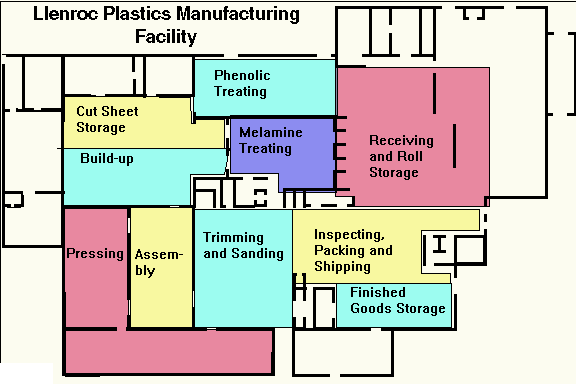
School of Operations Research and Industrial Engineering
Cornell University
Sponsored in part by the National Science Foundation Synthesis Coalition for Engineering Education.
(Sampler of multimedia factory tour: contact authors for details of full version)
Copyright (1994): The images associated with this document are copyrighted. Commercial use without the written consent of the authors is forbidden.

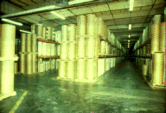 Printed Roll Storage
Printed Roll Storage
The first step in the manufacturing process is the receipt and storage of rolled paper. The rolls of paper are received from the suppliers in either 3,4, or 5 foot widths. These rolls arrive by truck or rail. Rail transport is used primarily to receive the large rolls of Kraft paper.
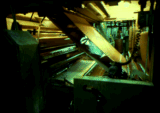 Phenolic Treating
Phenolic Treating
The rolls of Kraft paper are drawn from storage and treated with phenolic resin. Since the phenolic fumes are toxic, the Phenolic Treating Room is sealed from the rest of the plant.
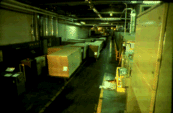 Kraft Cut Sheet Storage
Kraft Cut Sheet Storage
After treating, the Kraft paper is cut into individual sheets. The cut sheets of Kraft paper are stored on pallets in the Phenolic Treating room separate from the rest of the factory.
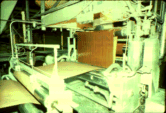 Melamine Treating
Melamine Treating
Rolls of printed paper are withdrawn from stock according to a production schedule. A prescribed amount of paper is removed from a roll and treated with melamine resin. The exact resin content varies among different types of paper. A precise resin mix is required to guarantee a high quality final product.
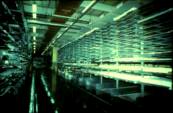 Cut Sheet Storage
Cut Sheet Storage
Once it completes the treating process, the treated printed paper is cut into individual sheets of lengths 8,10 or 12 feet. Altogether, there are 9 standard sizes of paper that emerge from the treating operation, ranging from 3 x 8 to 5 x 12. Once the printed paper is cut to length, it is generally stored in racks according to pattern, color, and size. Currently there are 180 different colors and patterns in the product line, each available in the 9 standard sizes.
All the printed and overlay paper necessary for a complete press load is pulled from cut sheet storage and pre-assembled onto transportable racks according to a production schedule. The racks are moved by forklift truck to the assembly room. The number of sheets of treated Kraft paper needed for a press load is also pre-counted, stacked, and transported in preparation for final assembly.
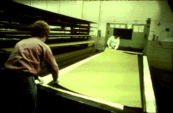 Assembly
Assembly
The individual sheets are assembled into so-called "books" prior to pressing. A book contains all the paper required to make two final pieces of laminate plus some additional paper. The name "book" comes from the fact that the resultant assembly is symmetric in content with the exterior printed pieces of paper called covers. The buildup team builds a stack of books on a moveable carrier. Each carrier holds five books (ten laminates). A stainless steel separating plate is placed between each pair of books. In coordination with the assembly team is a teardown team removing pressed laminates from a carrier that has left the press. The plates and empty carriers are transferred from the teardown station to the buildup station.
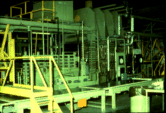 Press #3
Press #3
There are six presses in the plant. All the presses operate in essentially the same manner. Each press has a series of openings. Each opening can hold one carrier (10 laminates). The number of openings depends on the press. Once an entire set of carriers has been assembled, the load of carriers is moved into the press and the press cycle begins. The press cycle takes about one hour to complete. When it completes, the entire load of carriers is removed and the next load of carriers is moved in. The completed press load of carriers move to the teardown station one by one.
Following the pressing operation, the individual laminates are stacked onto pallets and moved in multiple press loads to a finishing area, called the fabrication room. The final trim and sanding operations, as well as some inspections, are performed here.
Each laminate is inspected, stacked, and either packaged and shipped directly to a customer or moved to the finished goods warehouse for storage.
The storage area consists of a high bay storage and retrieval system for low demand rate products and a set of ground level storage racks for high demand rate material.